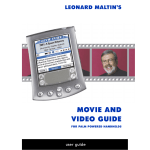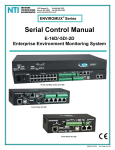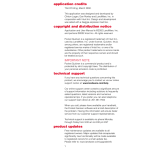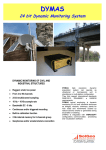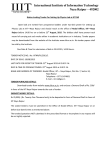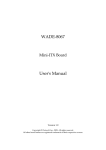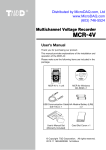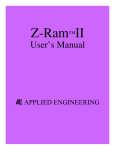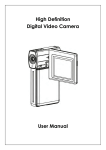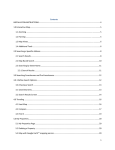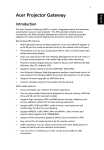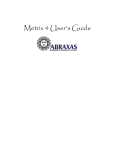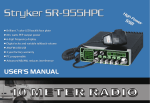Download FINANCIAL ASSISTANT
Transcript
owners guide ® M A G A Z I N E FINANCIAL ASSISTANT FOR PALM POWERED H A N D H E L D S Control your finances with more than 45 QUICKLY SOLVE self-calculating forms OVER 150 FINANCIAL PROBLEMS BY JUST FILLING IN THE BLANKS LandWare, Inc. Software License Agreement PLEASE READ THIS LICENSE AGREEMENT CAREFULLY BEFORE USING THIS SOFTWARE. BY USING THIS SOFTWARE, YOU AGREE TO BECOME BOUND BY THE TERMS OF THIS LICENSE. IF YOU DO NOT AGREE TO THE TERMS OF THIS LICENSE, DO NOT USE THIS SOFTWARE. The software (“Software”) provided along with this License, is licensed, not sold, to you by LandWare Incorporated (“LandWare”) for use only under the terms of this License, and LandWare reserves any rights not expressly granted to you. You own the media on which the Software is recorded, but LandWare and its licensors retain ownership of the Software itself. 1. License. This limited, non-exclusive License allows you to: (a) Use one copy of the Software on a single handheld computer at a time. To “use” the Software means that the Software is either loaded on the permanent memory or external memory card of a handheld computer. (b) Make one copy of the Software in machine readable form solely for backup purposes. You acknowledge that making additional copies or duplicating the software by any other means including electronic transmission is illegal. You may not copy the printed materials, if any, that accompany the software, or duplicate copies of user documentation. 2. Restrictions. (a) The Software contains trade secrets in its human perceivable form and, to protect them, you may not REVERSE ENGINEER, DECOMPILE, DISASSEMBLE OR OTHERWISE REDUCE THE SOFTWARE TO ANY HUMAN PERCEIVABLE FORM. YOU MAY NOT MODIFY, ADAPT, TRANSLATE, RENT, LEASE, LOAN, NETWORK, PROVIDE FREE, OR CREATE DERIVATIVE WORKS OF, OR BASED UPON, THE SOFTWARE OR PART THEREOF. (b) You may not transfer all your rights under this License to another party. 3. Termination. This License is effective until terminated. This License will terminate immediately without notice from LandWare or judicial resolution if you fail to comply with any provision of this License. Upon such termination you must destroy the Software, all accompanying written materials and all copies thereof, and Sections 5, 6, and 7 will survive any termination. 4. Limitation of Liability and Damages. IN NO EVENT WILL LANDWARE, OR ANY OF THE LICENSORS, DIRECTORS, OFFICERS, EMPLOYEES OR AFFILIATES OF ANY OF THE FOREGOING BE LIABLE TO YOU FOR ANY CONSEQUENTIAL, INCIDENTAL, INDIRECT OR SPECIAL DAMAGES WHATSOEVER (INCLUDING, WITHOUT LIMITATION, DAMAGES FOR LOSS OF BUSINESS PROFITS, BUSINESS INTERRUPTION, LOSS OF BUSINESS INFORMATION AND THE LIKE), WHETHER FORESEEABLE OR UNFORESEEABLE, ARISING OUT OF THE USE OF OR INABILITY TO USE THE SOFTWARE OR ACCOMPANYING WRITTEN MATERIALS, REGARDLESS OF THE BASIS OF THE CLAIM AND EVEN IF LANDWARE OR A LANDWARE REPRESENTATIVE HAS BEEN ADVISED OF THE POSSIBILITY OF SUCH DAMAGE AND EVEN IF A REMEDY SET FORTH HEREIN IS FOUND TO HAVE FAILED OF ITS ESSENTIAL PURPOSE. LandWare's sole liability to you for any direct damages for any cause whatsoever, and regardless of the form of the action, will be limited to the greater of $50 or the money paid for the LandWare Software (based on fair market value of the Software) that caused the damages. THIS LIMITATION WILL NOT APPLY IN CASE OF PERSONAL INJURY ONLY WHERE AND TO THE EXTENT THAT APPLICABLE LAW REQUIRES SUCH LIABILITY BECAUSE SOME JURISDICTIONS DO NOT ALLOW THE EXCLUSION OR LIMITATION OF LIABILITY FOR CONSEQUENTIAL OR INCIDENTAL DAMAGES, THE ABOVE LIMITATION MAY NOT APPLY TO YOU. 5. Consumer Information. As a condition of this License, LandWare may gather end-user registration and hardware and software version information. This information will be used to notify customers and make decisions about support, product and business issues. 6. General. This Agreement sets forth LandWare’s entire liability and your exclusive remedy with respect to the Software. You acknowledge that this Agreement is a complete statement of the agreement between you and LandWare, and that there are no other prior or contemporaneous understandings, promises, representations, or descriptions regarding the Software or any related services. This Agreement does not limit any right that LandWare or its Licensors may have under trade secret, copyright, patent, trademark or other laws. The Representatives of LandWare are not authorized to make modifications to this Agreement, or to make any additional representations, commitments, or warranties binding on LandWare, other than in writing signed by an officer of LandWare. Accordingly, any such additional statements are not binding on LandWare and you should not rely upon such statements. 7. Governing Law and U.S. Government Restricted Rights. This License will be construed under the laws of the State of New Jersey, except for that body of law dealing with conflicts of law If any provision of this License shall be held by a court of competent jurisdiction to be contrary to law, that provision will be enforced to the maximum extent permissible, and the remaining provisions of this License will remain n full force and effect If you are a U S Government user then the Software is provided with “RESTRICTED RIGHTS” as set forth in subparagraphs (c) (l) and(2) of the Commercial Computer Software Restricted Rights clause at FAR52227-19 o sub paragraph (c) (1) (ii) of the Rights in Technical Data and Computer Software clause at DFARS 52 277-7013, as applicable Manufacturer LandWare Incorporated P.O. Box 25, Oradell, NJ. application credits First Printing, September 2002. This application was designed and developed by Clinton Logan and LandWare, Inc. in cooperation with MONEY Magazine. disclaimer of warranty The set of worksheets contained within this application are designed as self-help tools for your independent use. It is important to note that their applicability to your circumstances cannot be guaranteed. We encourage you to seek personalized advice from qualified professionals regarding all personal finance issues. copyright and distribution notice The MONEY Magazine Financial Assistant application and user manual is ©2002 LandWare, Inc. All Rights Reserved. MONEY 101 content is copyright © 2002 CNN America, Inc. An AOL Time Warner Company. All Rights Reserved. MONEY is a registered trademark of Time Inc. Used under license. The Glossary content is ©2002 Campbell Harvey. IMPORTANT NOTE The Financial Assistant is a commercial product and is protected by strict copyright laws. The distribution of your personal activation code is prohibited. technical support If you have any technical questions concerning this product, we encourage you to contact us via our online support center at: www.landware.com/help Our online support center contains a significant amount of support information including solutions to frequently asked questions, latest versions and operational tips. Technical support is also available via phone Monday to Friday from 9:00 am to 6:00 pm EST at (201) 261 7944. When you call, please have available your organizer, the Financial Assistant software and a brief description of the problem. Having this information will ensure faster service from our customer support representatives. product updates Free maintenance updates to the application are available to all registered owners. Full information can be found at: www.landware.com/upgradeinfo 3 GETTING STARTED welcome Thank you for choosing the MONEY Magazine Financial Assistant for Palm OS. We have worked hard to make this product a powerful yet easy to use financial tool for personal and business use. We hope that you will soon find it to be an invaluable addition to your handheld. The Financial Assistant is a feature rich product so we encourage you read the entire documentation to get the most out of your software. installing the financial assistant To install the Financial Assistant, follow the steps below. Windows installation instructions: 1. Insert the CD into your CD-ROM drive. 2. The installer should automatically activate. If not, then select Run from the Windows Start menu and enter x:setup, where x is the letter assigned to your CD-ROM drive. 3. Follow the installer’s instructions on screen. 4. Select the correct user name for your handheld and click on the Next button. 5. Press the HotSync button to install the application and glossary data onto your handheld. 6. Now follow the steps overleaf to activate the application. HANDHELD REQUIREMENTS: • • • • • Palm OS 3.0 or greater Financial Assistant application Money 101 Tutorials database* Standard Glossary database* Large Glossary database* 415K 30K 140K 546K * These databases may be omitted to conserve memory if the glossary and/or Money 101 tutorials are not required. NOTE: To ensure acceptable search and navigation performance the Glossary.pdb database must be installed on the handheld’s internal memory. The application can reside on a Palm OS expansion card if desired. Macintosh installation instructions: 1. Insert the Financial Assistant CD-ROM into your Macintosh CD-ROM drive. 2. Double-click on the installer icon. 3. Follow the instructions on screen. 4. Ensure you select the correct user name when prompted. 5. Press the HotSync button to install the application and glossary data onto your handheld. 6. Now follow the steps overleaf to activate the application. SD Card installation instructions: 1. Insert the Financial Assistant SD card into your handheld’s expansion slot. 2. Follow the steps overleaf to launch and activate the application. 4 launching the financial assistant Once installed, the icon depicted to the left will appear in the application launcher of the handheld. By default it is placed in the Unfiled category. Tap the icon to launch the application. PRODUCT ACTIVATION The Financial Assistant will function for 14 days before requiring you to enter a valid activation code. This period is provided for the express purpose of product evaluation prior to purchasing. If you have already purchased this product you should enter your personal activation code now. This will ensure you are able to use the application on an ongoing basis. If you obtained the Financial Assistant electronically: 1. Launch the Financial Assistant application. 2. Tap the Register Now button. 3. Enter your personal activation code (as provided by the LandWare sales representative) onto the Enter Code field. 4. Tap the Register button. If you obtained the Financial Assistant on a CD-ROM: 1. Launch the Financial Assistant application. 2. Tap the Register Now button. 3. Enter your personal activation code as found on the inside of the CD-ROM case. 4. Tap the Register button. If you obtained the Financial Assistant on an SD card: 1. Insert the Financial Assistant SD card into your handheld’s expansion slot. 2. Launch the Financial Assistant application. 3. Tap the Register Now button. 4. Enter your personal activation code as found on the product registration card. 5. Tap the Register button. 5 OPERATIONAL OVERVIEW the main worksheet list view The main worksheet list provides a collection of 45 intuitive “fill-in-the-blanks” worksheets, conveniently grouped into 8 categories. Each worksheet has been especially designed so non-experts and experts alike can make over 150 real-world financial decisions including: • Loans, Leasing and Mortgages • Marketing and Investment Analysis • Personal Finance • Everyday Math • Lease vs. Buy • Retirement Planning • Long-Term savings TIP: Enter the first letter of a worksheet name to quickly advance the list to the applicable worksheet. Tap the Worksheet category popup menu (shown as All Worksheets in the above illustration) to display a list of all worksheets associated with a financial category. FAVORITE WORKSHEETS In addition to the precompiled worksheet categories, the Financial Assistant allows you to create your own personal list of frequently used worksheets. To display your favorite list of worksheets: 1. Tap the worksheet category popup menu. 2. Tap on the Favorite Worksheets entry. To add a worksheet to your favorite list: 1. Scroll to the worksheet entry in the list view 2. Tap and hold the stylus on the worksheet name. 3. Select Add to Favorites from the popup menu. OPENING A WORKSHEET Tap on the name of the worksheet you want to use. Full details are provided on page 7. TIP: Tap and hold the stylus on the worksheet name for a fraction of a second to quickly access the worksheet details. OPENING THE FINANCE GLOSSARY Tap on the icon to open the Financial Glossary. Full details are provided on page 9. OPENING THE MONEY 1O1 TUTORIALS Tap on the icon to open the Money 101 tutorials reader. Full details are provided on page 9. 6 working with worksheets While each Financial Assistant worksheet has been designed for a specific purpose, the worksheets have many features in common. Once you are familiar with these features, you can use any worksheet in the collection with confidence. The Financial Assistant contains a vast variety of worksheets which all share the common format illustrated to the left. ENTERING INFORMATION You can enter data directly into the fields identified with a dotted underline using graffiti, the handheld’s keyboard or the integrated onscreen number pad. TIP: To validate the current set of values within a worksheet, tap on the current result field name (with highlighted white on black text). TIP: To move to the next field. enter a return or tab character or press the hardware scroll buttons on the handheld. Tap on a field with a dotted outline to open a secondary details slip. This slip allows you to enter further information that generates the result for that field. Some worksheets can solve multiple problems for a given set of input values. The current result field is indicated by white text on black background (e.g Current Savings in the above illustration). To choose an alternative calculation within a worksheet, tap any field icon. (e.g Annual Yield, Annual Contriname with an bution, Ann. Retire Income etc.) Calculation results are automatically displayed once a valid set of input values have been entered. USING THE ONSCREEN NUMBERPAD The Financial Assistant provides an integrated onscreen number pad to help enter and calculate data. To use the on-screen number pad: 1. Tap twice quickly on an empty field. The keypad to the left will appear. 2. Tap in the digits of the desired number. 3. Tap OK. The number pad facilitates “on the fly” calculations as well as the ability to store intermediate results in its continuous memory. The number-pad’s open action (double-tap by default) can be altered in the Financial Assistant’s preferences screen. Full details are on page 10. 7 OPENING A DETAILS SLIP To enter data into a worksheet, you occasionaly need to enter secondary information into a popup details slip. A details slip is opened whenever you tap on a field with ). Each slip has a set of a dotted outline (e.g fields on which you can enter data. When you close the slip, the result or summary appears in the main worksheet. Some slips also allow you to customize the field labels to suit the particular problem at hand. To erase all data values from a details slip: button. All previously entered 1. Tap the values will be deleted from the worksheet. To delete the entry from the main worksheet: 1. Tap the Delete Button. This slip is deleted (along with the corresponding entry on the main worksheet). USING ONLINE HELP Help is just a tap away. Each worksheet is equipped with a detailed description and a set of examples to further illustrate its use. To access the online help from a worksheet: 1. Tap the Help button at the bottom of the screen. 2. Select WorkSheet Description... from the popup menu. creating financial schedules Obtaining detailed insight into your financial planning is as easy as a single tap. The Financial Assistant provides customizable schedules for its savings, mortgage, loan and depreciation worksheets. To create a schedule for a given worksheet: 1. Enter the data into the worksheet. 2. Tap the schedule button 3. The schedule will be generated on-screen. To advance the schedule to a given payment or period: 1. Tap the Show... button 2. Select Specific Item... 3. Enter the payment or period number. 4. Tap the OK button. 8 using the financial glossary The Financial Assistant provides a financial glossary which covers all aspects of business and finance. To lookup a financial term: 1. 2. 3. 4. TIP: Tap on the definition text to scroll the term definition down by four lines. TIP: Tap on the alphabet tabs to quickly advance the list to the term that begins with that letter. Example: Tap def to advance to the term beginning with ‘d’. Tap it again to advance to ‘e’. Tap it a third time to advance to ‘f’. Tap the glossary button Enter the first letter of the term you want to find into the Look Up field. The list will scroll to the financial terms that start with that letter. Continue entering characters until the term you are looking for is highlighted or visible. The definition of the term will automatically be displayed in the lower half of the screen. The Financial Assistant offers the choice of two optionally installable glossaries: A standard 1,700 term edition which covers the core of the business language and an encyclopedic version which contains over 7,200 terms and definitions. money 101: top things to know The Financial Assistant includes an optionally installable set of electronic tutorials created by the editors at MONEY Magazine. Each tutorial has been especially designed to help you invest, save, borrow and spend more wisely. Whether you are interested in the basics of banking and saving, investing in mutual funds or just want to control your debt, the essentials of each tutorial can be easily absorbed while you are on the go. To access the money 101 tutorial topics: 1. Open the main worksheet list view. icon at the bottom of the screen. 2. Tap the To access a money 101 tutorial: 1. Scroll to the lesson entry in the list view 2. Tap on the lesson name. For those who want to dig deeper be sure to visit www.money.com/pf/101 for greater detail—including calculators, quizzes and a library of supplemental materials. 9 configuring financial assistant MONEY Magazine Financial Assistant provides a number of different options that allow you to customize the way it works. Selecting the Preferences command from the Options menu opens the preferences window allowing you to customize the following: GENERAL PREFERENCES Tap the General tab on the preferences window to specify the following attributes: • Tapping a Field Entry — Specify the default editing behavior when you tap on a input field. • Confirm Data Deletion — Financial Assistant will prompt before deleting worksheet values. • Row Shading — Select to fill alternate lines in the schedule views with a background color. To change the color, tap on the Pick Color... button. DEFAULT VALUES Tap the Default Values tab on the preferences window to specify the following attributes: • Currency Symbol — Specify the currency symbol used within the worksheets. • Inflation Rate — Specify the default inflation rate to use. At the time of printing this is approximately 2.3% in the United States. • Tax rate — Specify your current tax rate or tax bracket for which you pay on earnings during the year. • Show favorite worksheets on launch — Select to display the favorite worksheet list every time the Financial Assistant is opened. 10 WORKSHEET REFERENCE Each Financial Assistant worksheet is designed for a specific purpose. By familiarizing yourself with its unique features, you can make the fullest use of each worksheet. The explanations in this section include practical examples of how to use each worksheet, as well as definitions of financial terms. Worksheet field names appear in italics. loans and mortgages CASH NEEDED TO BUY A HOME When you purchase something with a very high purchase price, such as a home, your are likely to get a loan for most of the purchase price. The remainder — the amount you have to pay in cash— will determine what you can afford to buy. Be sure to take into account all possible expenses— you want to make sure you have enough cash. A down payment is a partial payment of the offer price; You can enter the down payment as a percentage of the offer price (% Downpayment) or as an amount (Down payment Amt.) Tap the Financing Costs, Legal Fees, Other Payments and Cash Receipts buttons to enter the respective costs. The seller may expect reimbursement for certain prepaid expenses such as property tax and utility bills. You might have to pay Discount Points if you get a Federal Housing or Veteran’s Administration loan to finance the purchase. Each point is 1% of the loan amount. You pay a Recording Fee to record your title to the property (the deed) in the county courthouse. You pay an attorney a title option fee to review title evidence and render an option about the condition of the title (that is, whether the seller really owns the property and if there are any liens against it). 11 You may have to pay a transfer tax to transfer the property title. A Cash receipt is an amount the seller owes upon your purchase of the property. The Cash Needed to buy is the amount you need available immediately upon purchase, including the downpayment. Example problems: • How much cash is needed to buy a house if you offer $225,000 with a 10% down payment, and $5,000 of repairs and $1000 legal fees are needed immediately? COMPARE LOANS Use the worksheet to calculate and compare the payment, principal and interest of different loans. Tap the New Loan button to enter the details of the new Loan. Tap the Loan entry line to edit or delete the loan. Example problems: • • Do you pay more Interest on a $12,000 loan over 3 years or a $10,000 loan over 2 years if the other loan conditions are the same? What is your monthly payment for a $100,000 loan you must pay back over 20 years, if the interest rate is 5% compared with 4.75%? GET A LOAN Use the worksheet to determine the annual interest rate, amount or periodic (e.g monthly) payment of your loan. The Loan Term is the length of time you have to pay back the total Loan Amount. Most loans require 12 payments per year— one each month. It is assumed that you make the payment at the end of each period. Example problems: • • TECH NOTE: Interest is compounded at the same frequency as payments are made. • 12 What would your Payment be each month on a $10,000 loan at 7% interest for 5 years? What Loan Amount can you afford to borrow if you can repay $4000 a month for 25 years and the current interest rate is 8%? What Annual Interest Rate do you need to borrow $15,000 for 3 year, if you can repay no more than $500 per month. HOW MUCH CAN YOU BORROW? Use this form to determine the maximum size of your loan, based on how much you can pay each month. Example problems: • • How much can you borrow if you can afford a monthly payment of $300 for a term of 2 years and the interest rate is 8%? What mortgage amount can you afford if you can make monthly payments of $900 over 25 years at an interest rate of 9.25% MAKE AN EXTRA PAYMENT Use this form to help you determine the impact of making an extra payment on a loan. The principal is the amount on which interest is charged (that is, the amount of the loan or mortgage). “Paying down the principal” with extra payments is the fastest way to reduce the interest cost of a loan. Example problems: • • If you have a $200,000 loan requiring a monthly payment of $800 at 6% interest for 20 years, and you make an additional principal payment of $10,000, what is the Amount saved? How much is your Term reduced by on a bank loan of $5,000 being repaid over 3 years, if you make an extra payment of $400 at the end of the year? REFINANCING YOUR MORTGAGE Use this worksheet to determine how soon a refinanced mortgage will pay for itself (that is, how soon it will pay for the closing costs and penalties of the former mortgage). Your tax rate is the percentage of combined taxes you pay on earnings during a year (your tax bracket). Tax Deductible (closing) costs can be deducted from income before taxes. The after-tax rate of return is the percentage return you really get from an investment after you pay tax on the profit. Example problem: • 13 If you refinance your mortgage at a lower interest rate so your monthly payment is $700 instead of $800, when will you actually start saving money? STANDARD VS. BALLOON MORTGAGE Use this worksheet to determine and compare standard and balloon mortgage amounts. A balloon mortgage is like an ordinary (standard) mortgage, except you agree to pay off the balance on a certain date when the mortgage officially ends. A balloon payment is the balance of the mortgage on the payoff date. A balloon payment makes your monthly payment smaller, thus it increases the total amount you can afford to borrow. When you choose a balloon mortgage over a standard one, however, you should be sure that you can really afford to make the balloon payment when it is due. You can also use the Balloon mortgage details slip to calculate balloon loans and leases as well. Example problems: • • • Which type of mortgage would carry less Total Interest on a $120,000 mortgage over 15 years? With which type of mortgage could you borrow more Principal at a 9% interest rate and payments of $1,200 per month? How much are your payments on a $100,000 mortgage at 7% interest if you plan to make a $15,000 balloon payment? WHAT IS YOUR BALLOON PAYMENT? Use this worksheet to determine the amount of a balloon payment, based on the terms of a loan. Example problem: • 14 What final balloon payment must you make if you have a $25,000 loan and 3 years until the balloon payment is due? WHAT IS YOUR LOAN BALANCE? Use this worksheet to determine the outstanding balance of your loan or the number of payments you have made to date. The period is the length of time between payments, and determines how often interest is added to the loan. The Payment per Period is the regular payment amount you make on your loan. The Payments per Year field allows you to specify how often payments are made (e.g enter 12 for monthly payments, 2 for Bi-Annual etc.) TECH NOTE: Interest is compounded at the same frequency as payments are made. Payments are assumed to occur at the end of the compounding period. If interest is compounded and applied at intervals that do not coincide with payments (i.e Canadian Mortgages), use the Compare Interest Rates worksheet (below) to convert the interest rate to an equivalent interest rate with compounding periods that match the regular payments. Example problems: • • What is your Outstanding Balance on a 3-year loan at 8% interest if you have made 11 payments of $345 each? What Number of payments have you made on a 25-year loan at 7% interest if your outstanding loan balance is $124,500 and your monthly payment is $1250 the value of money COMPARE INTEREST RATES Use this worksheet to convert and compare interest rates with varying magnitudes and compounding frequencies. Interest rates are normally expressed as a Nominal Rate which reflect an annual rate that is compounded periodically (e.g 6.8% compounded Quarterly). When investments have different compounding periods (i.e monthly vs. quarterly) then Effective Rates are used to compare them. The Effective Rate is an annual measure of an interest rate that fully reflects the effects of compounding. In personal finance the effective rate is commonly called the Annual Percentage Rate (APR). Example problem: • Which of the following offer the best interest rate? - ANZ Bank: 6.7% annual interest compounded daily - ASB Bank: 6.8% annual interest compounded quarterly. 15 COMPOUND AMOUNT AND INTEREST Use this worksheet to calculate the compound amount and compound interest of a loan or investment. Compound interest is interest for one period that is added to the principal before the interest for the next period is calculated. The Interest is paid interval determines how often the interest is calculated and added to the principal amount. The Compound Amount is the final amount paid or earned (principal amount plus Interest Earned). Example problems: • • What is the Interest Earned in 1 month in a bank account holding $13,000, if the interest rate is 4% compounded daily? What is the final, compound amount you really pay after paying back a $12,000 loan at 6.25% interest over 5 years? CURRENCY CONVERSION Use this worksheet to convert between eight user defined currency amounts based on any exchange rate. Enter the currency amount you want to convert from and the other currency values will be updated automatically. To edit the currency labels and/or exchange rates: 1. Tap the Edit Items button 2. Edit the Name and/or Rate field 3. Tap the Save button Exchange Rates are specified as a ratio from your base currency. The base currency normally corresponds to your home currency and has an exchange rate of 1.0 All other exchange rates are expressed as fractions of the base rate i.e Base currency = Foreign currency x Rate To import exchange rates from Pocket Quicken: 1. Tap the Edit Items button 2. Tap the Import Rates... button Example problem: TECH TIP: For exchange rates to be correctly updated you must ensure the correct three letter ISO 4217 code has been entered for each currency. • 16 How much is a DVD player that sells for $670 New Zealand Dollars in your home currency? DEPRECIATION Use this worksheet to determine the depreciation of an asset using three common calculation methods. Depreciation is the allocation of an asset’s cost to future income periods over which the asset is used. Use the Straight Line method (Str. Line) if the asset depreciates the same amount every year. Use the Sum of years-digits method (Sum of Yrs) if the asset depreciates more in the early years. Use the Declining Balance method (Dec. Balance) if the asset depreciates at a certain percentage (the Declining Balance factor) of its original value each year. If you are using the Declining Balance method enter the declining-balance factor as an Annual Discount percentage off the original value or as a multiple of the straight-line depreciation rate (Str. Line Multiple). The Asset Salvage Value is its estimated selling price at the end of the depreciation period. Enter the remaining Length of 1st year for situations in which the acquisition date of an asset does not coincide with the start of a tax or fiscal year. Enter the year for which the depreciation will be calculated into the Calc. Value After field. The Depreciated Value is the difference between the Original Asset cost and the Asset Salvage value. Tap the button to instantly view a depreciation schedule on-screen. Example problem • 17 What is the Depreciated value of your new car after 3 years if its original cost was $25,000, its expected life is 12 years, its salvage value is $3,000, and you are using the Straight Line method of depreciation? THE FUTURE VALUE OF MONEY Use this worksheet to determine the future value of periodic payments you are paying or receiving today. The Future Value of money is the value, at a given future date, of a series of equal payments you are making or receiving, compounded at a given interest rate. Use the future value to compare different investment opportunities or potential obligations. Enter the # Payments per Year to specify how often payments are made (e.g. 12 for monthly payments, 2 for Bi-Annual payments etc.) TECH NOTE: Interest is compounded at the same frequency as payments are made. Payments are assumed to occur at the end of the compounding period. Example problem • If interest is compounded and applied at intervals that do not coincide with Payments, use the Compare Interest Rates worksheet to convert the interest rate to an equivalent interest rate that with compounding periods that match the regular payments. What is the Future Value, after a 20-year term, of a retirement account to which you contribute monthly payments of $100 and which earns 8.25% interest? THE PRESENT VALUE OF MONEY Use this worksheet to determine the current value of periodic payments you will pay or receive in the future. The Present Value of money is today's value, discounted at a given Annual Interest Rate, of periodic payments you will make or receive in the future. Use the Present Value to compare different investment opportunities or potential obligations. To a lender or borrower, Present Value is the amount of a loan; to an investor, Present Value is the size of the initial investment. TECH NOTE: Interest is compounded at the same frequency as payments are made. Payments are assumed to occur at the end of the compounding period. Example problems: • 18 What is the Present Value of 5 annual payments you will receive of $6,000, if the interest rate is 9% make investments BOND PRICE AND YIELD Use this worksheet to determine the price you should pay for a bond or the interest rate on a bond held to maturity. The Annual Coupon Rate is the interest rate stated on the bond. The Bond Price is expressed “per $100 face value” or in other words the price you really pay for a $100 bond. The Yield to Maturity is the actual interest rate you expect for the bond. This is usually the prevailing rate on the investment market when you buy the bond. TIP: To ensure responsive data entry performance during Yield to Maturity calculations it is recommended that the Maturity Date is entered last. TECH NOTE: All calculations are based on a 365day year. Interest is compounded semi-annually. Example problems: • • What is the price of a bond you will own from Jan. 1, 2001 to June 30, 2010, if the annual coupon rate is 9.75% and the bond's yield will be 12% What is the yield of a bond with a purchase (settlement) date of Oct. 10, 2001 and a maturity (redemption) date of Oct. 10, 2011, if the annual coupon rate is 11% and the bond's actual price per $100 is $103.50? FUTURE VALUE OF A LUMP SUM Use this worksheet to determine the future value of an initial lump sum of money deposited in an interest earning investment account. The Investment’s Future Value is the Initial Investment sum's value at a given future date, compounded at a given interest rate. Interest is compounded (calculated and added) to the principal amount at a specified frequency. Example problem: • 19 What is the value after 10 years of a $5000 certificate of deposit (CD) earning 7% interest per year. SALES VOLUME, PRICE AND PROFIT Use this worksheet to determine: How many units of a product you must sell to make a certain profit or the price you must charge per unit to make a certain profit or the total profit you will make on that product. Tap the Variable Costs/Unit button to record the costs that vary in relation to the volumn of units sold. Tap the Fixed Costs button to record expenses (such as packaging design) that do not vary with the volume of activity or output of that product. To find the gross profit at a given volume, tap the Total Profit label and fill in the rest of the worksheet. TIP: To find the break-even point, enter 0 as the Profit. Example problem: • • How many cameras must you sell each month to break even if you buy each camera for $275, sell each for $399, and your fixed costs per month are $5,000 What will your profit be if you sell 100 of these cameras each month? THE TERM OF A LUMP SUM Use this worksheet to determine how long it takes an investment to grow to a given value at a specified interest rate and compounding frequency. Example problem: • How many years will it take you to become a millionaire if you initially invest $100,000 at 14% interest. WHAT INTEREST RATE DO YOU NEED? Use this worksheet to find the interest rate required for an Initial Investment to reach a Desired Future Amount. The Interest is Added (or compounded) into the investment account at regular intervals. Example problem: • 20 What Annual Interest rate will turn a $10,000 investment into $50,000 in 15 years if interest is paid monthly. analyze your investments ANALYZE YOUR CASH FLOW Use this worksheet to analyze investments that involve cash flows (money paid out or received) of uneven amounts that occur on an annual basis. The Net Present Value (NPV) of an investment is the present value of the expected future cash flows minus the cost or cash outflows, at a given interest rate. One of three possible results will be displayed: 1. 2. 3. TECH NOTE: This worksheet assumes investments meet the following criteria— (1) Initial Investment is a cash outflow, (2) Some of the cash flows following the initial investment are positive, (3) the sequence of cash flows change signs only once, and (4) the sum of the cash flows is positive. A positive value — Revenue target exceeded, an effective investment. Zero — Revenue target met. A negative value — Revenue target has not been attained, an ineffective investment. The Net Future Value (NFV) is the future value of all cash inflows and outflows, at a given interest rate. The Net Uniform Series represents the amount that is equivalent to the series of cash flows having a PV equal to the NPV. The Internal Rate of Return (IRR) is the return at which future cash flows, discounted back to today equal the initial cash outlay. If the Internal Rate of Return is greater than the desired rate of return or the Net Present Value is positive, the investment is considered financially attractive. To add a cash flow item: 1. Tap the Add Button. 2. Enter the cash flow amount into the Amount field. Enter cash outflows as negative values. 3. Enter the number of times a cash flow amount occurs consecutively in the occurrences field. To insert a cash flow item: 1. Tap the item number of the cash flow item 2. Select Insert... from the popup menu. 3. A new cash flow entry will be inserted before the selected item. To delete a cash flow item: 1. Tap the item number of the cash flow item. 2. Select Delete... from the popup menu. Example problem: • 21 What is the Internal Rate of Return for an investment that requires a cash outlay of $50,000 with annual cashflows of 3 x 5000, 4 x10000 , 0 and 3 x 15000 dollars. CAPITALIZATION RATE FOR PROPERTY Use this worksheet to calculate the capitalization rate for an investment property. The Capitalization Rate is the ratio of a property's annual net operating income to its market price. You can use it to compare the returns on rental properties; the higher the capitalization rate, the greater the return, or chances of producing reliable income. The Vacancy Allowance is the percentage of annual rent you may lose while the property is vacant. Example problem: • What is the Capitalization Rate of a duplex that has a market price of $150,000, produces annual rents of $24,000, costs $9,450 a year in operating expenses, and has a 15% vacancy allowance? ESTIMATE RETURN ON STOCK Use this worksheet to analyze the relationship between an investment's risk and return using the Capital Asset Pricing Model (CAPM). The Beta Value is a measure of how sensitive an investment is to market movements. As the Investment’s Beta Value increases, return (and risk) increase as well. The Beta Value can be positive (investment rises in value when market rises) or negative (investment drops in value when market rises). The Risk-Free Rate, Return on Market and Beta values can be obtained through stock brokerage firms or publications. Example problem: • The beta value for a company is 1.2. The Risk-Free rate of return (current rate of Treasury Bill securities) is 7%. Given 333the expected rate of return for the market as a whole is 9% what is the expected rate of return for the stock? MAINTAIN YOUR PURCHASING POWER Use this worksheet to determine the rate of return you need on an investment to maintain purchasing power given the effects of inflation. To maintain your purchasing power, you must earn enough on your investment to be able to buy the same items in the future you could buy today with that amount. Example problem: • 22 What Rate of return must you receive on a bond to maintain current purchasing power, assuming the inflation rate is 3% and your marginal tax rate is 26%?3 personal finance HOW MUCH LIFE INSURANCE Use this worksheet to determine the amount of life insurance coverage your beneficiary may need to cover future expenses in the event of your untimely death. A beneficiary is someone you name to receive income from your insurance policy. Probate costs are the fees associated with registering and certifying a will. The Investment Yield is the yearly rate your beneficiary earns on the insurance capital. The higher the yield, the less capital you need. Example problem: • How much Life Insurance do you need so that your beneficiary can receive $10,000 cash and enough capital to have a monthly income of $1,200 for 20 years? YOUR NET WORTH Use this worksheet to record your total assets and total liabilities and to determine your net worth. Most people know their credit card balance, but not their net worth— a much more important number. Your Net Worth is the difference between yourTotal Assets and Total Liabilities. In other words what you own minus what you owe. This worksheet is analogous to a corporation's balance sheet and provides a snapshot of your financial situation. It is important to gain a clear picture of your net worth before developing a financial plan designed to help you reach your financial goals 23 everyday math DATES AND TIMES Use this worksheet to calculate the difference between specific dates or times. Select the 30-Day Month check box when you want to base the calculations on the 360-day calendar and do not have to know the exact number of days involved in the calculation. Tap the Beginning Date or Ending Date selector button to display the Day of the Week. Dates are calculated using the exact calendar method which assumes each year (except a leap year) has 365 days. Example problems: • • For how many days do you earn interest if you open a savings account on May 24th and close it December 1st? How many hours have you been alive? PERCENTAGE CALCULATIONS Use the percentage worksheet to perform various percentage calculations. The percentage worksheet is divided into two screens: Percentage of Total and Percentage Change. Tap the Percent Change tab to display the worksheet for calculating the Percentage change between an Old Value and a New Value. Percent Change is expressed as a percentage of the Old Value. Tap the Percentage of Total tab to display the worksheet for calculating the percentage a Part of Total represents of a Total Amount. Percent of total is expressed as a percentage of the Total Amount. The percentage worksheets calculate any unknown variable as long as the other two are known. Example problems: • • 24 By what Percentage Change did your rent increase if it went from $975 to $1,120 per month? What amount of sales tax should you pay on a $237 purchase, if the tax rate is 8%? PRICE FOR PROFIT! Use this worksheet to calculate various relationships between markup, margin, selling price and cost price. Selling Prices are often set using a Markup or Margin on a Cost or Buy Price. The Margin is the gross profit rate based on the selling price expressed as a percentage of the selling price. The Markup is the gross profit rate based on the cost or buy price expressed as a percentage of the cost price. Example problem: • What is the appropriate Selling Price for an outboard motor that costs $378.50 to make, if you want to achieve a 33% markup? PRICES OF MULTI-SIZED PACKAGES Use this worksheet to compare the prices of two packages, regardless of their sizes or units of measure. Example problems: • • Is it cheaper per pound to buy 1000 pounds of crushed granite for $360 or 1 ton for $685? Is the $2.50 1-liter bottle of juice really cheaper than the $3.00 1.5 quart bottle, if you compare their prices in quarts? SAVE BY BUYING IN BULK Use this worksheet to calculate the price per unit of an item sold in bulk, and to determine if you save money by buying the item in bulk rather than in single units. Example problems: • • 25 What are your Total Savings and Percent Savings if you buy 12 boxes of disks for $99.99 rather than 1 box for $9.79? Is it cheaper to buy a 24-can box of soda for $15.00 or individual cans at 70 cents each? SPLIT A BILL, TAX AND TIP Use this worksheet to calculate tax, service gratuity and divide a bill evenly amongst a group of people. Simply enter the tax inclusive Subtotal of the restaurant bill to have the Base Amount and Tax portions automatically calculated. This allows you to quickly verify the restaurant’s Tax calculation and addition. Tap the and buttons at the bottom of the screen to round the Amount per person (and TOTAL) up or down to the next whole dollar. The Tip percentage is automatically updated. Example problems: TIP: This worksheet is also available as a free standalone application which includes extensive “Tipology 101” advice on tipping etiquette. Full details can be found at www.landware.com/tipassistant. • • • How much is the tip on a lunch bill of $106.00 split 4 ways, if each person pays $31.00? What percentage does a $16 tip paid on top of a $120 bar tab represent? How much does each person from a group of five pay on a $230 bill with a 18% gratuity fee added? buy, lease or rent? COMPARE LEASES Use this worksheet to compare the costs and payment features of different leases. Tap the First Lease Cost button to enter the details of the first Lease. Repeat for the second Lease. If you plan to buy the item when the lease ends, tap the Take Purchase Option check box and enter a Purchase option price within the details slip of each lease. You may also agree to make an extra Balloon Payment when the lease ends. On some leases, you can Defer payments for a specified number of periods. Tap the Compare button to view a summary of the leases' costs as shown to the left. Use the Total PV Cost (Present Value capitalized cost) and Annual PV Cost in the comparison schedule to compare the true costs of the two leases. Example problem: • 26 Which office equipment lease is better: one that requires 12 payments per year of $900 and no down payment or security deposit, or one that requires 12 payments per year of $700 with a down payment of $300 and a security deposit of $200 LEASE OR BUY? Use this worksheet to compare the costs and features of leasing versus buying. An item's Residual Value is its value, expressed as a percentage of the original purchase price, after you pay off the loan. Equity at End of Term is the value of the item, expressed in dollars, after you pay off the loan. Tap the Compare button to view a summary of the Buy and Lease costs as shown to the left. The Lease verses Buy line details the cost difference between leasing the item and buying it. A negative value indicates that Buying would be financially less desirable. Example problem: • Do you pay lower monthly payments for a $20,000 car at 6% if you buy the car or lease it for 5 years? RENT OR BUY? Use this worksheet to compare the costs and features of renting with buying a property. The Own/Rent Duration is the length of time (in years) you plan to keep or rent the property. The Savings Interest Rate is the rate you will earn if you invest your money rather than using it as a downpayment on the property. Tap the Mortgage Payment button to enter the Mortgage details such as Down payment, Interest rate and Term. The Marginal Tax rate is the tax rate you would have to be paid on any additional dollars of taxable income earned. Tap the Selling Price button to enter the annual appreciation rate (the percentage by which the property value increases each year.) 27 The Property resale fees are the percentage of the selling price that you must pay the real estate agent for selling the property. Tap the Compare button to view a summary of the Rent verses Buy costs as shown to the left. The Investment/month value on the compare schedule is the difference between Total Monthly Cost and Monthly Rent. The Effective Yield value on the compare schedule is the annuallized return received when you purhcase the property which fully reflects the costs of ownership. Example problem: • Which would be wiser: to buy a condominium with a $20,000 down payment and $689 mortgage payments, or to invest the $20,000 and rent the apartment for $700 per month? savings and retirement PLAN YOUR CHILD’S TUITION Use this worksheet to determine how much you must save (Annual Contribution) to pay for tuition in the future. The Rate of Return is the annual interest rate you expect your savings to earn. Enter a Predicted Inflation rate to adjust tuition costs. If you do not have any savings, enter 0 into the Current Savings field. Tap the button to generate the expected savings and expenditure schedule shown to the left. Example problems: • • 28 What Annual Contribution must you make to be able to pay $6000 a year in tuition fees for 4 years? What Current Savings should you have if you plan to set aside $1,000 each year to pay $20,000 tuition in 8 years? REACH YOUR SAVINGS GOAL Use this worksheet to determine how you can save a certain amount of money over a specified period of time. The Annual Yield is the expected return (such as interest, dividends, or profit) on money you save each year. Tap Balance in Today’s $ to see how inflation affects the purchasing power of your money. Tap the button to track the expected accumulation of savings. If you enter a Predicted Inflation rate, this schedule also shows the increase in the contributions necessary to maintain your savings goal. Example problems: • • • If you deposit $500 per month for the next 3 years, what starting savings balance do you need to build your savings to $20,000? What regular contribution must you make to save $10,000 in 5 years for a new car, if you have saved $500 already? What is your end savings balance if you deposit $110 a month for 5 years? RETIRE RICH! Use this worksheet to determine how you can achieve a particular income upon retirement. Annual Pension Income is money you will receive upon retirement in addition to your retirement savings. If you enter an Inflation Factor, the schedule shows the increase in contributions necessary to maintain your savings goal. Tap the Income in Today’s $ checkbox (within the Inflation factor details slip) to see the purchasing power your income would have today. Amounts decrease when you choose this option because inflation reduces the value of money you save for the future. Example problems: • • • 29 What must your Current Savings be to have an annual retirement income of $24,000 for 20 years? What Annual Yield must your savings earn to have such an income, if you are able to contribute $3,000 a year for 30 years? What will your Annual Retirement Income be if you have $10,000 in the bank already and plan to contribute $2,500 a year for 20 years? WITHDRAW FROM SAVINGS Use this worksheet to determine how much you can withdraw regularly from your savings or the number of months you can withdraw a particular amount. Enter a Predicted Inflation rate to adjust the withdrawal amounts so they reflect the impact of inflation. Tap the button to generate a schedule of expected withdrawal events. Example problems: • • 30 How much can you Withdraw each month if you are earning 7% interest on $5,400 an you would like your savings to last 6 months? For what Withdraw Period can you withdraw $700 from a retirement savings account holding $25,000?

































